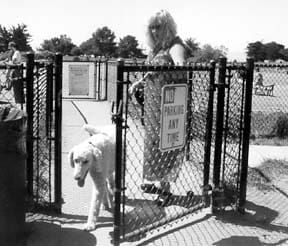You’re lucky. You have a fabulous dog park in your community. But so far, you’ve hesitated to turn your beloved buddy loose with the pack of rowdy canines you’ve seen playing there. Or maybe your dog is so unruly that you’ve worried about your ability to get him back on leash once he’s been emancipated. Here are some tips to help you decide whether you two are ready to lose the leash at the park.
First, visit the park without your dog. Observe the interactions between dogs and humans. Do the dogs seem to be getting along well? Are the humans friendly and helpful? Are they willing to answer your questions? If you pick up a negative vibe, try visiting the park at another time of day, or another day of the week. You may have just met the one bad apple at the park; every park has one – non-dog parks included!
Walk the entire park perimeter. Important park design features include adequate access and parking to avoid neighborhood congestion, double-gated entrances to prevent dogs from escaping, well-maintained fences and grounds, an adequate water supply, and a large enough area to minimize space conflicts between dogs. Is the fence well constructed and maintained to prevent escapes? Is it high enough to keep your dog from flying to freedom?
Look for waste-disposal implements and containers. Parks stay cleaner if there are waste containers in several locations throughout the park. These containers should be lined and covered, and emptied frequently. Pooper-scoopers or bags should be plentiful.
Criss-cross the park grounds. Are there hazards present, such as piles of neglected dog feces, broken glass, and foxtails, or is the area clean and safe?
Read the park rules; they should be prominently posted at the park entrance. Are they reasonable rules that you can comply with? Do they enhance the safety and enjoyment of canine and human users?
Now, evaluate your dog’s social skills with a critical eye. Does he enjoy being with other dogs? Can you maintain his attention and obedience even in the company of other dogs? You want the dog park experience to be a positive one for him – and for you. It won’t do him any good to spend the whole time hiding under a picnic table, cowering in fear of a roving pack of rowdy dogs; in fact, it could even make a fearful dog develop some self-protective aggressive behavior. You want to enjoy the experience, too; no one wants to spend an hour trying to catch a dog who hasn’t learned to reliably come whenever he is called (for help with this skill, see “Total Recall,” December 2000).
Seek out experienced help for remedial socialization or training. If your dog is timid, visit the park at several different times of day, and try to find a time when usage is at its lowest. Seek out one or two other gentle or timid dogs and see if you can arrange play dates at low-use times when you can have an underused corner of the park all to yourselves. Repeated good experiences with other non-threatening dogs may be just what your dog needs to get brave about dog park play.
However, if your dog is aggressive, bite the bullet and admit that the dog park is not for the two of you, at least not until you have done successful behavior modification with an experienced positive trainer.
Never leave your dog unattended. Remember, a dog park is not a doggie day care center where you can go and forget about your responsibilities as a dog owner. You must keep a constant eye on your furry pal, to be sure he is neither bullying a smaller dog nor being bullied by a tougher one. Stay alert for signs of tension, and learn how to gently and positively interrupt potential conflict by cheerfully separating the dogs or removing the object of contention.
Keep a sense of humor. Parents who have spent hours at public parks with their children are well aware that not all kids who are there to play are well-behaved, or even nice! Sooner or later, you’ll meet a dog you don’t like. Smile, call your dog, and go explore another corner of the park.
Also With This Article
Click here to view “The Pros and Cons of Dog Parks”
Click here to view “Dog Parks Help Socialize and Exercise Dogs in a Safe Way”
-By Pat Miller






